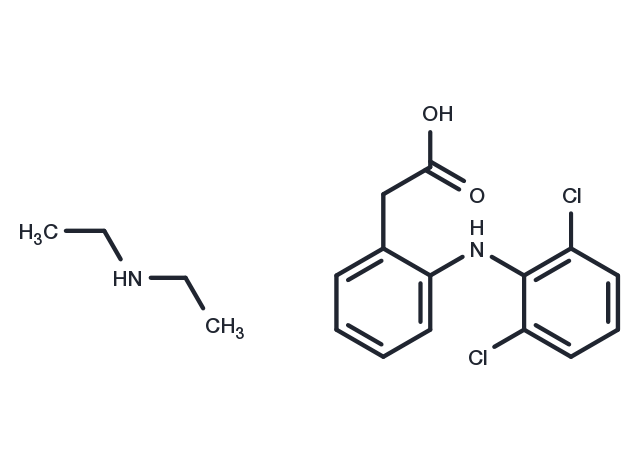Powder: -20°C for 3 years | In solvent: -80°C for 1 year


Diclofenac Diethylamine, a non-selective COX inhibitor, is utilized as a nonsteroidal anti-inflammatory drug (NSAID).

| Pack Size | Availability | Price/USD | Quantity |
|---|---|---|---|
| 5 g | In stock | $ 56.00 | |
| 10 g | In stock | $ 94.00 | |
| 1 mL * 10 mM (in DMSO) | In stock | $ 50.00 |



| Description | Diclofenac Diethylamine, a non-selective COX inhibitor, is utilized as a nonsteroidal anti-inflammatory drug (NSAID). |
| Targets&IC50 | COX-2 (human, CHO cells):1.3 nM, COX-1 (human, CHO cells):4 nM, COX-1 (ovine):5.1μM, COX-1 (ovine):0.84 μM |
| In vitro | The primary mechanism of diclofenac diethylamine responsible for its anti-inflammatory, antipyretic, and analgesic action is thought to be inhibition of prostaglandin synthesis by inhibition of cyclooxygenase (COX). It also appears to exhibit bacteriostatic activity by inhibiting bacterial DNA synthesis. Inhibition of COX also decreases prostaglandins in the epithelium of the stomach, making it more sensitive to corrosion by gastric acid. This is also the main side effect of diclofenac. Diclofenac diethylamine has a low to moderate preference to block the COX2-isoenzyme (approximately 10-fold) and is said to have, therefore, a somewhat lower incidence of gastrointestinal complaints than noted with indomethacin and aspirin. |
| Kinase Assay | HDAC Activity: HDAC activity is measured using a continuous trypsin-coupled assay. For inhibitor characterization, measurements are done in a reaction volume of 100 μL using 96-well assay plates. For each isozyme, the HDAC protein in reaction buffer [50 mM HEPES, 100 mM KCl, 0.001% Tween 20, 5% DMSO (pH 7.4), supplemented with bovine serum albumin at concentrations of 0% (HDAC1), 0.01% (HDAC2, 3, 8, and 10), or 0.05% (HDAC6)] is mixed with PCI-24781 at various concentrations and allowed to incubate for 15 minutes. Trypsin is added to a final concentration of 50 nM, and acetyl-Gly-Ala-(N-acetyl-Lys)-AMC is added to a final concentration of 25 μM (HDAC1, 3, and 6), 50 μM (HDAC2 and 10), or 100 μM (HDAC8) to initiate the reaction. Negative control reactions are done in the absence of PCI-24781 in replicates of eight. Reactions are monitored in a fluorescence plate reader. After a 30-minute lag time, the fluorescence is measured over a 30-minute time frame using an excitation wavelength of 355 nm and a detection wavelength of 460 nm. The increase in fluorescence with time is used as the measure of the reaction rate. Inhibition constants Ki(app) are obtained using the program BatchKi. |
| Molecular Weight | 369.29 |
| Formula | C18H22Cl2N2O2 |
| CAS No. | 78213-16-8 |
Powder: -20°C for 3 years | In solvent: -80°C for 1 year
Ethanol: 69 mg/mL (186.8 mM)
H2O: < 1 mg/mL (insoluble or slightly soluble)
DMSO: 69 mg/mL (186.8 mM)
You can also refer to dose conversion for different animals. More
bottom
Please see Inhibitor Handling Instructions for more frequently ask questions. Topics include: how to prepare stock solutions, how to store products, and cautions on cell-based assays & animal experiments, etc.
Diclofenac diethylamine 78213-16-8 Apoptosis Immunology/Inflammation Neuroscience COX Cyclooxygenase anti-inflammatory cascade CHO COX-1 neural Inhibitor NSCs stem ovine caspase inhibit cells COX-2 Diclofenac inhibitor
